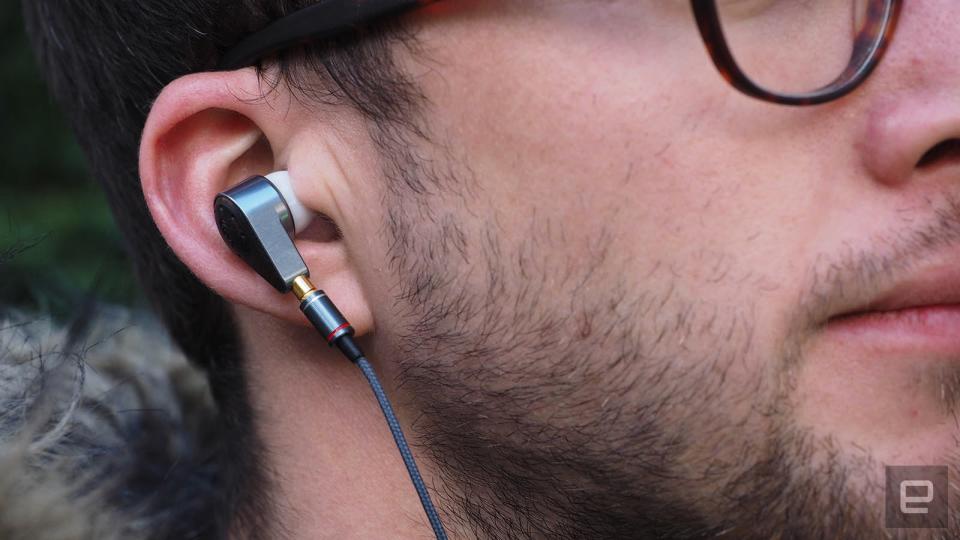The sweet sound of the 'world's most expensive' earphones
I've learned I'm too cheap to truly enjoy nice things.

I imagine I'm like most people in that I'm fairly content with a leaky pair of earphones that came bundled with a phone I bought 18 months ago. Some of you will have more expensive tastes, of course, dropping a few hundred on a "nice" pair of Beats, Sonys or similar cans. But there's a whole other world out there, where money is seemingly no object in the pursuit of the perfect sound. And for roughly a week, I've been masquerading as an audiophile myself, wearing oBravo's EAMT-1 in-ear headphones that cost no less than £3,600 (roughly $4,413). Yes, you read that right.
Made by an obscure Chinese company, these earphones are "the world's most expensive" -- a claim I haven't been able to debunk. We're only talking in-ears here, though. There are plenty of over-ear headphones around that price and more. Some are way, way more.
As far as in-ears are concerned, though, the EAMT-1s are as expensive as they come, backed up by the proprietors of exclusive UK stockist Audio Sanctuary, who were silly kind enough to lend me a pair. (The store appears to be the only place on the entire internet you can buy oBravo's latest right now, in fact.)

I wish I could tell you exactly why these earphones are so damned expensive, but the deeper my research has gone, the more oblivious I become. The language used to describe the technical capabilities of the EAMT-1s is even more alien to me than the vocabulary audiophiles employ to explain the various qualities of sound. To illustrate what I mean, this is Audio Sanctuary's explanation of oBravo's Air Motion Transformer (AMT) technology:
"The AMT diaphragm is made of a Mylar ribbon bonded with conductive aluminium strips. It is equivalent in surface area to a conventional seven-inch cone-type mid-range driver, but is accordion-folded down to a compact one-and-a-half-inch grouping for point-source dispersion. The low-mass diaphragm is suspended within a dipole magnetic field concentrating an intense field around said diaphragm. When signal current passes through the aluminium strips, the ensuing bellow-like motion of the folded pleats moves air five times faster than with a conventional cone driver."
How anyone without a degree in sound engineering is supposed to make any sense of that, I don't know. Apparently, though, the 8mm AMT tweeter (for mid- to high-ish frequencies like vocals and hi-hats) paired with a 13mm neodymium dynamic driver is primarily what you're paying for. I'm reliably told that crafting an extremely high-end earphone is markedly more complex than making a great-sounding pair of over-ears simply because there's so much less space to work with.
Though I hate to be skeptical, the opinion that money is directly related to quality is common in specialist circles, particularly when audio and video are concerned. Some cables sell for $1,000, for example, even though the vast majority of people wouldn't say there's any difference between them and a $10 equivalent. An audiophile, however, might claim the difference is stark. It's that kind of subjectivity, compounded by impenetrable lingo, that can blur the line between genuine innovation and snake oil.

With my skeptical hat returned to its drawer, I can say the EAMT-1s just ooze quality, from the smooth metal and rich, dark wood of the backplates to the luxuriously wrapped cables. Every connector is gold of course, and you can actually detach individual buds and swap the lead out for one with a 2.5mm jack. I didn't even know those existed. Because of the earphones' coaxial design, they are much deeper than "normal" in-ears. But at 35g, they aren't noticeably heavy and are perfectly comfortable to wear all day, especially with the included Comply tips made from expanding foam.
The pair I've been testing have a handmade ceramic enclosure, chosen because the material is relatively inert from a resonance perspective -- meaning it barely interferes with driver output (Yay! Something I actually understand!). The ceramic version is described as the best of the best, but you can also request the EAMT-1s with an aluminum enclosure that's supposed to offer a more "neutral" sound, or an Acacia-wood enclosure for extra warmth.
Materials and build quality aside, the EAMT-1s sound absolutely incredible. I mean, you'd hope so for nearly $4,000, but it's quite hard to communicate the clarity of these earphones. Listening to the Cure's greatest hits in high-res FLAC format, for example, I can practically pick out the moment each string of a chord leaves the plectrum; similarly, I swear I can hear the creak of bass-drum pedal on some of my favorite Foo Fighters tracks. The clarity and depth are insane, like you're sitting in the recording booth as these songs are being played.

And that's with the EAMT-1s plugged directly into my MacBook, which I'm sure will anger one or two people who would probably argue I have no idea what they really sound like as I'm not running them through a dedicated DAC/headphone amp.
Because the output is so crisp and clear, the EAMT-1s feel at their best when there's a lot going on in a track. By that I mean several guitars, drums, vocals, effects, et cetera. That said, simpler arrangements sound great too. The Wu-Tang Clan's 1993 album Enter the Wu-Tang (36 Chambers), for example, or Kendrick Lamar's Untitled Unmastered from earlier this year. Never have heard I bass so ... beautiful as on the EAMT-1s. The low-end is real deep and silky smooth. It's not kick or volume, just pure bass tones.
But the thing is, it's extremely rare for me to be sitting at my computer listening to high-def audio, especially as I have a pretty slim collection. The vast majority of the time -- and I'm talking pretty much all day, every day -- I'm jacked into Spotify. And I'm talking free Spotify here, where the maximum bitrate is roughly 160 kbps. While that sounds, well, fine on a pair on phone-bundled buds, the EAMT-1s expose every flaw. You might as well be listening to a Galaxy S2's loudspeaker at the other end of tin-can telephone, to massively exaggerate the point.

Where high-res tracks give a real sense of presence, the same songs piped through Spotify on my phone sound muddy, ill-defined and distant. You can literally feel the compression like a haze hanging over the track -- especially if it hasn't been expertly produced and mixed. But I'm not an audiophile, and there's only so long I can pretend to be one, with my paltry FLAC library and nonexistent Tidal subscription. Simply put, oBravo's EAMT-1s aren't made for muggles like me.
This was never more obvious to me than when I took them out of the safety of my flat. I was genuinely nervous carrying around a pair of earphones I couldn't even dream of affording, knowing that soon enough I'd be returning to them to Audio Sanctuary, a task I'm seriously looking forward to. I can't deal with that kind of responsibility. What if one fell out of my ear and somehow I managed to shatter a ceramic enclosure? What if I left them on the bus? People who can afford $4,000 earphones probably don't have to worry about that, though. I doubt they catch buses very often.

